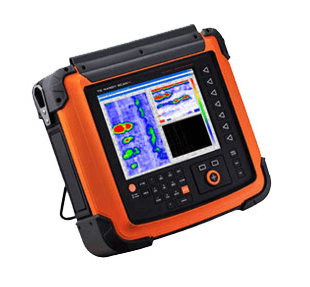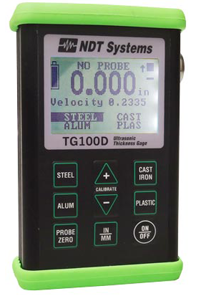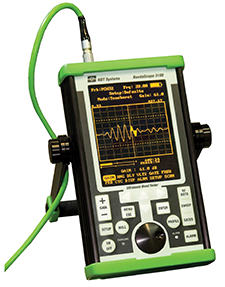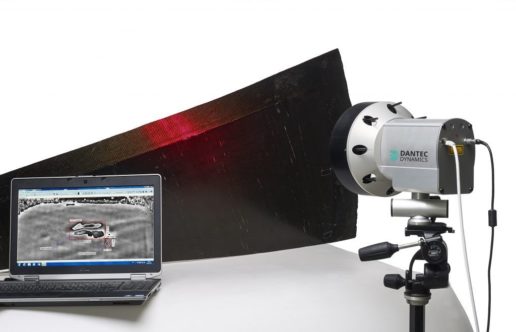NDT refers to a set of methods employed to examine materials and component in such a way that provides material examination without changing or destroying their usefulness. Such a technique can be used to identify and size the surface and subsurface flaws and defects.
NDT is often used as a Quality Assurance management tool, necessary to reassure the safety and reliability of equipment used in the oil and gas industry. Applications of NDT can be found in oil platforms, refineries, pipelines, power stations, airplanes, space shuttles, motor vehicles, and so on. These are all inspected using NDT methods. The materials which fail to meet the NDT tests also fail to achieve what they were designed for. They are also prone to survive less than their projected life due to undetected defects which later on becomes fatal. Modern day NDT methods can be used in all stages of equipment life, be it manufacturing, fabrication or in-service. This results in product integrity and reliability as well as the control over manufacturing processes to lower production costs, while maintaining a uniform quality level.

Rugged and Portable Phased Array Sensor
Application
- Critical plant items in construction and in-service
- Pressure Systems – Vessels, pipelines, pipe-work
- Storage facilities – Tanks, spheres
- Tubed Vessels - Boilers, Heat Exchangers, Condensers
- Service induced defects & structural damage
- Stress/chemically assisted micro-cracking - SCC, LTHA, HHA, SOHIC
- Corrosion/erosion profiling - especially weld root erosion
- Thick wall components > 300mm
- Clad/lining interface bond/cracking
- Fabrication QC - includes ‘in-situ’ construction

Rugged and Portable Phased Array Sensor
Advantages
- Highly Accurate and Sensitive
- Increased Evidence
- Fast
- Comprehensive Coverage
- Meaningful Presentation
- Fast Reporting / Decision Making
- Permanent Record of All Parameters
- Offline Interpretation and Measurement
- Objective Assessment.
- Excellent Repeatability.
The requirement for accurate thickness measurements is found across many industries including aerospace, oil and gas, pharmaceutical and food processing. Either for quality control in manufacturing or in-service verification often access is only available from one side and speed is critical. The wall thickness from most materials can be measured ultrasonically including metals, composites, plastics and glass using a simple hand-held digital gauge.
In certain environments, a coating of paint or other non-metallic material may have been applied to protect the part. A common application would be a painted pipe used in the petrochemical industry. In this case a conventional ultrasonic gauge would give measurement errors from the presence of the paint. However, with the correct gauge with through paint mode, measurement through the paint is possible resulting in the correct wall thickness measurement underneath.
NDT Systems offers a range of standard and high-resolution thickness gauges with features including A-trace display, B-scan, automatic probe recognition, data logging and much more. Furthermore, large area thickness mapping (C-scan) can be achieved using our Raptor imaging flaw detector and range of scanners.
Transducer (Probe) Type
Contact transducer – probes which transmit a pulse of compressional sound into the specimen at the right angles (normal) to its surface. It is the most common used transducer type for thickness measurement.
Delay Line transducer – in order to facilitate the complete inspection of thin plate sections it is necessary to eliminate the effect of the probe units dead zone and the earlier part of its near filed in which those areas of the interfering sound pressures exist. A normal angle probe is mounted on a plastic, epoxy or fused silica known as a delay block between probe element and test specimen
Immersion transducer – special waterproofed probes used in immersion testing which allow thinner and higher frequency crystals without face wear plates can be used with less chance of damage caused by probe handling encountered during contact scanning
Dual Element (Twin Crystal) transducer – comprises two crystals act as transmitter and receiver respectively which gives good sensitivity to near surface defects and measurement

Results Obtained by Ultrasonic Tester
Materials
- Metals
- Plastics
- Composites
- Glass
- Fiberglass
- Ceramics

Results Obtained by Ultrasonic Tester
Typical Applications
- Turbine blade thickness
- Corrosion & pitting
- Boilers Glass
- Storage tanks
- Pipes and tubing
- Metal sheet processing
- Aerospace & automotive manufacture
- Investment Castings
- Chemical milling

As the use of adhesively bonded joints and fittings has increased across many industries, the need for testing bond integrity has grown. Metal to metal bonded joints, sandwich constructions with various skin and core materials, bonded carbon fibre composite structures have all become important in manufacturing as well as in-service repair patches and adhesively bonded re-inforcements. The integrity of these bonds is critical to the quality of the final product. Conventional ultrasonic methods can be limited for these applications and so a variety of alternative methods have been developed to handle this range of material combination.

Hand Held Quick Setup Portable Composite Bond Testing
Inspection Methods
- Pitch-Catch RF
- Pitch-Catch Pulsed
- Pitch-Catch Swept
- MIA Fixed Frequency
- MIA Swept Frequency
- Resonance
Application
- Multi-layered laminates
- Skin to core flaws
- Glass fiber/ carbon fiber composites
- Far-side defects
- Honeycomb and foam cores
- Impact damage
- Metal to metal bonding
- Adhesively bonded fittings
- Liquid Ingress
Shearography is an optical Non-destructive testing method that provides fast and accurate information about internal anomalies in different materials. Sherography is being extensively used in production, research and development and in-field within the aerospace, automotive, marine and wind industry.
Loading Conditions
- Thermal
- Vacuum
- Vibration
- Acoustic
- Mechanical

Company Portable customizable accurate Laser Shearography
Applications
The main applications for shearography are for quality assurance of composite and other materials. Depending on the material strength and depth of defects within a sample, Shearography can detect most discontinuities that occur in composite structures, including disbonds; delaminations; cracked core; crushed core; kissing bonds; wrinkling; fluid ingresses; porosity; cracks; repair defects; and impact damage (BVIDs). Additional structural information such as ply drops, bulkheads, overlaps, splices, stringers, ribs can also be detected.

Appication
Inspection Standard:
The NDT industry is controlled by Inspection Standard Documents. Shearography is incorporated in the following standard documents:
- ASNT SNT-TC-1A
- ASNT CP-105
- ASTM E2581
